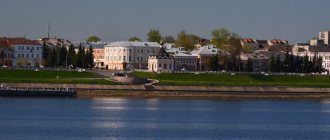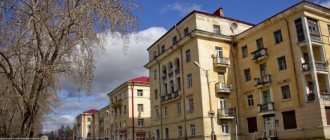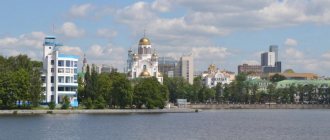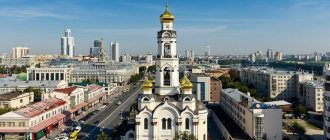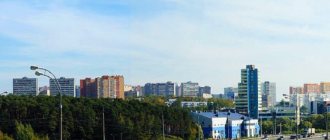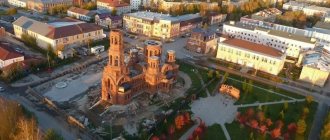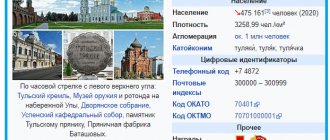MENDELEVSK
MENDELEEVSK, a city in Russia, in the north-east. parts of Tatarstan, center of the Mendeleevsky municipal district. Us. 21.8 thousand people (as of 1.1.2021). Located on the right bank of the river. Kama, 8 km from the railway station. Tikhonovo. The Almetyevsk – Naberezhnye Chelny – Izhevsk (Udmurtia) highway passes through Moscow.
Story
Founded in 1868 as a settlement at the chemical plant of P. K. Ushkov (one of the oldest in Russia; now the “Chemical Plant named after L. Ya. Karpov”). To the beginning 20th century the name was assigned to the village. Bondyuzhsky. In 1921–25, an experimental radium production plant operated here (one of the first in the USSR). Since 1928 it has been a workers' settlement. In 1930–31, 1935–63, the center of the Bondyuzhsky district of the Tatar Autonomous Soviet Socialist Republic. The city of M. (named in honor of D.I. Mendeleev, who in 1893 established the production of smokeless gunpowder at a chemical plant) was formed in 1967 with the merger of the working village. Bondyuzhsky, s. Quiet Mountains, village Bondyuga (both founded in the 2nd half of the 17th century) and the village. Lenino (1801; until the 1920s, the village of Mirnoye Pristanishte, or Kamashevo). Since 1985, the regional center of the Tatar Autonomous Soviet Socialist Republic (1985–90), Tatar SSR (1990–92), and the Republic of Tatarstan (since 1992). Since 2005, the center of the Mendeleevsky municipal district. In 2022 it received the status of a territory of rapid socio-economic development.
Architecture
Within the boundaries of M., the Tikhogorsk settlement (8th–5th centuries BC) and a settlement of the 12th–13th centuries were discovered. n. e. Among the monuments of religious architecture is the Church of the Epiphany (1815–28; rebuilt in the 1890s; reconstruction - 1990s). The buildings of the Ushkov estate (belonged to N.I. Kamashev, in 1861–1917 - to P.K. Ushkov) have been preserved: ch. house (mid 19th century), stone outbuilding (1860), wooden. house of L. Ya. Karpov (1915–18); park (partially). Also in M. - ex. building of the office of the company P.K. Ushkov (1870), 2-story building of the Adnashev estate (late 19th century). Industrial monuments architecture (last third of the 19th century) on the territory of the chemical industry. factory; hydroelectric complex “Noisy Bridge” (mid-19th century). Tang Mosque (1995). Memorial “Warrior-Liberator” (1976; reconstruction in 2015).
Farm
Leading enterprises - Chemical Plant named after. L. Ya. Karpov" (1868; consisting of; products of inorganic chemistry for metallurgy, petrochemical, medical industry and other sectors of the economy), "Ammonia" (founded in 1983 as the "Novomendeleevsky Chemical Plant"; current status and name with 2016; nitrogen fertilizers, ammonia, methanol; it includes the transport and logistics enterprise "Mendeleevskazot"). Furniture production, food industry enterprises.
Why should Chelny residents go to Mendeleevsk?
We start from the city of Mendeleevsk, on a clear day it can be seen from our bank of the Kama. The history of this city and its surroundings was told to Chelny News by Olga Bodnar, a senior researcher at the Mendeleevsk Museum of Local Lore.
For reference
The city of Mendeleevsk was founded in 1868. It is located on the right bank of the Kama River, on the border with Udmurtia. On August 11, 1967, the urban-type settlement of Bondyuzhsky was transformed into the city of Mendeleevsk. In January 2000, the city of Mendeleevsk received the status of a historical settlement and is now part of the Russian Union of Historical Cities and Regions. 22 thousand people live in Mendeleevsk. Today it is a city of chemists, where mineral fertilizers are produced and oil is extracted. More than 90 cultural heritage sites have been identified on the territory of the Mendeleevsky district, including 24 archaeological monuments, 28 historical monuments, 28 architectural monuments, 11 monuments of monumental art.
Monument of industrial architecture of the 19th century
In Mendeleevsk you can see factory chimneys, which are a monument of industrial architecture of the 19th century.
– In 1850, in the village of Kokshan, merchant and pioneer of the Russian chemical industry Kapiton Ushkov built his first chemical plant. As a result, it became the largest producer of chrompic (potassium dichromate) in Europe. In the 60-70s of the 19th century, the chemical plant’s products were exported to England, Holland and Prussia,” said Olga Bodnar, a researcher at the Mendeleevsk Museum of Local History.
After the sudden death of Kapiton Ushkov, his son Pyotr Kapitonovich becomes his successor. He takes responsibility for the work of the Kokshansky and the second plant under construction, which is located closer to the Kama, in an empty swampy area near the village of Bondyuga. The Bondyuzhsky plant, which produced its first products in 1868, quickly became one of the leaders of the Russian Empire in the production of chemical products. Thanks to the efforts of Peter Ushkov, the annual income of the family enterprise increases from 200 thousand rubles to 4 million. Workers' barracks, a factory office, and social infrastructure facilities are being built around the plant, which became the basis of the workers' village of Bondyuzhsky, then the city of Mendeleevsk.
– In 1893, the famous Dmitry Mendeleev, on the instructions of the Naval Ministry, began work on the production of smokeless gunpowder and chose the Bondyuzhsky chemical plant of the merchant Ushkov as the experimental site, since by that time the enterprise had become one of the largest and most advanced in the Russian Empire. He wrote: “I, who knew many Western European chemical plants, saw with pride that what a Russian figure had created could not only not be inferior, but also in many ways surpass foreign ones,” Olga Bodnar quotes the great scientist. In 1893, on the recommendation of Mendeleev, a plant for acid-resistant ceramic products and fireclay bricks came into operation in Kokshan. The square near the Cathedral of Notre Dame de Paris was paved with paving slabs from Kokshan.
Mendeleevsk became the hero of Boris Pasternak’s novel “Doctor Zhivago”
Boris Pasternak made Bondyuga, that is, Mendeleevsk, the prototype of the village of Varykino from his famous novel “Doctor Zhivago”. He ended up in Mendeleevsk in 1916 at the age of 26 and lived for a year working as a factory employee.
– Pasternak called Bondyuga Manchester on the Kama. She became the prototype not only of the village of Varykino from the famous novel “Doctor Zhivago,” but also of the stories “District in the Rear” and “Lovelessness,” written by him based on Bondyuzh impressions, said Olga Bodnar.
The memory of the stay in Bondyuga of D. Mendeleev, B. Pasternak, scientists L. Ya. Karpov, B. I. Zbarsky, public figures S. N. Gassar, N. K. Krupskaya and many others is preserved in an ancient building built in 1870, the former office of the Partnership of Chemical Plants P.K. Ushkov and Co., where the city's local history museum is now located.
The office of the Partnership of Chemical Plants P.K. Ushkov and Co., where the city museum is now
City's legends
There are many urban legends in Mendeleevsk, but the most mystical is the story associated with the building of the church on the Quiet Mountains.
– In the Soviet 70-80s, the church building on the Quiet Mountains looked more like ruins and was considered a place where all sorts of mysteries and miracles were concentrated, where spirits hovered, and with the arrival of darkness, all sorts of evil spirits came out of the basements of the abandoned temple. In some places on the floor of the temple lay preserved tiles from the time of the Ushkovs, under which, people said, ancient coins and banknotes could be found. Apparently, for this reason they tried so carefully to tear the tiles off the floor, says a museum researcher.
Church on the Quiet Mountains
The old people talked about the existence of an underground passage leading to the opposite bank of the Kama and passing directly under the river. According to another version, an underground passage led to Elabuga to some monastery. After the revolution, the move seemed to be specially closed. So far no one has been able to discover the passage. Now this church is functioning and does not look like ruins at all.
A similar underground passage existed in another part of the city and connected the main house of the Ushkov estate with Yelabuga.
Another urban legend is associated with the cave.
Not far from Mendeleevsk, downstream of the Kama, on a steep bank there is a cave, which is popularly called “Pugachevskaya” or “Stepan Razin”. Legend says that, passing by these places, the atamans stopped in a cave to rest, hiding in it from bad weather and the royal troops. Treasures looted during campaigns were also hidden here. Many tried to find them.
But, as researcher Olga Bodnar says, urban legends are just that: legends. They are not confirmed by archives, and were composed by people who were ready to believe in all sorts of mysteries and miracles.
Where do Mendeleev's people hang out?
In Mendeleevsk, as throughout Tatarstan, modern parks and public gardens are being built. Most often, local residents choose the Ushkovsky Islands park, located in the historical center of the city, for walks. In addition to the complex of ancient buildings, the park has a pond with swans, access to the Toima River, walking areas, observation decks, a pump track and much more. And it is in this park that the only monument to the factory whistle in Russia is installed.
Fountain in Mendeleevsk park
What places in the city of Mendeleevsk should tourists visit?
1. Epiphany Church, built in 1809-1825.
2. Ushkovsky Islands Park.
3. The building of the "Commune" theater, built in 1893.
4. Estate of P.K. Ushkov.
5. . It was there that Dmitry Mendeleev and Boris Pasternak worked.
photos provided by the local history museum of the city of Mendeleevsk and the editorial office of the newspaper “Mendeleevskyi News” https://mendeleevskyi.ru/
Name
In the name of the agglomeration, the name of the city of Lisichansk comes first, since during the period of the emergence and growth of the agglomeration Lisichansk was the largest city in the region, and since the end of the 19th century it gave rise to the emergence and development of the chemical industry in the south of the Russian Empire (1892), as well as the emergence and development of neighboring settlements and industrial centers. At the moment, the largest and most important city in the agglomeration in terms of population is Severodonetsk, while Lisichansk has retained its territorial superiority.
Economic specialization
Chemical (Severodonetsk, Lisichansk, Rubezhnoye) and oil refining industries (Lisichansk), mechanical engineering (Severodonetsk, Lisichansk) and instrument making (Severodonetsk), coal industry (Lisichansk), food industry (Lisichansk, Severodonetsk, Kremennaya), building materials industry (Severodonetsk, Rubezhnoe ), oil and gas industry (Severodonetsk, Kremennaya).
Industry
This is the largest industrial hub of Donbass, in which powerful enterprises of the coal mining, chemical and mechanical engineering industries are concentrated:
- in Severodonetsk:
"Azot", OJSC "Stekloplastik", Severodonetsk Chemical and Metallurgical Plant, "Ukrhimenergo", "Severodonetsk ORGKHIM", Severodonetsk Instrument-Making Plant, Severodonetsk Resistance Plant, Severodonetsk Thermal Power Plant, Plant of Metal Building Materials and Structures, Severodonetsk Plant of Liquid Chemical Fertilizers "Novofert", "Chemical supplier, "Energokhimmash", "Khimmashkompressorservice", JSC "SNPO "Impulse", , Severodonetsk building ceramics plant, STKE, Severodonetsk woodworking plant, LLC NPP "Antex-avtomatika", Severodonetsk boiler-mechanical plant, LLC JV Ukrvneshtreydinvest, GNIPIHT " Chemical Technology", Severodonetsk Trade Equipment Plant "Vico", Severodonetsk Computer Assembly Enterprise "Best Way", Severodonetsk Bread Factory, Severodonetsk Dairy Factory, Cannery, LLC Fire-fighting Equipment Enterprise "Pirena", LLC "A. O. Mriya-Invest, etc.
- in Lisichansk:
coal mining association "Lisichanskugol" (5 mines), Lisichansky oil refinery, Lisichansky glass, Lisichansky glass (not working), Lisichansky soda (not working) and Lisichansky rubber-technical products plant "RTI" (almost not working), Lisichansky technical fabrics factory ( not working), Lisichansky Rare Gas Plant, Lisichansky Machine-Building Plant / "Strommashina" (not working), Lisichansky Thermal Power Plant, Lisichansky Christmas Tree Decorations Factory, Lisichansky Garment Factory, Lisichansky Bakery Plant, Lisichansky Meat Processing Plant, Lisichansky Dairy Plant, Lisichansky Brewery, etc.
- in Rubezhnoye:
"Yuzhny", "Zarya", Rubezhansky Cardboard and Container Plant, "Prominvest Plastic", OJSC "BKF", chemical, Rubezhansky Pipe, Automotive Repair Enterprise "Ferdinand"
Compound
The population of the agglomeration was calculated without taking into account temporarily displaced persons from the occupied territory, whose census is difficult to carry out. Their number within the agglomeration in 2022 is estimated at ~50 thousand people.
- cities (~322285 people): Severodonetsk (~109891 people, the core of the agglomeration, the largest city by population) settlements of the Severodonetsk City Council (~10373 people)
- Novodruzhesk (~7816 people)
- northern part of Popasnyansky district Volcheyarovka
- Smolyaninovo
- Varvarovka
